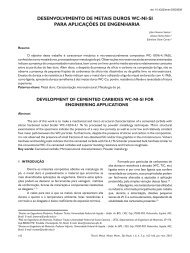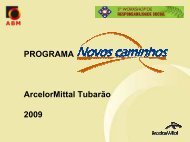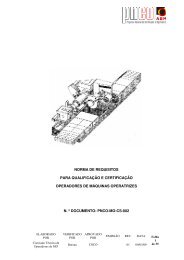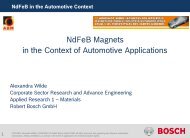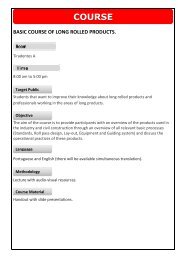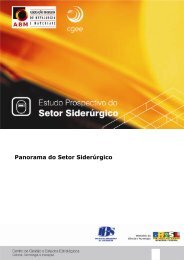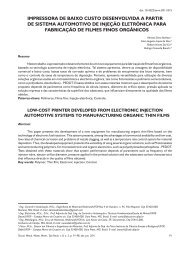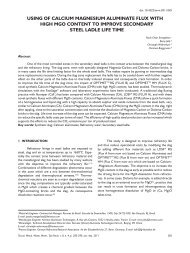gear drive - ABM
gear drive - ABM
gear drive - ABM
Create successful ePaper yourself
Turn your PDF publications into a flip-book with our unique Google optimized e-Paper software.
Application and Development in Large<br />
Scale Grinding Mill Gear Drive
1 Foreword
1<br />
SABC(ABC) will<br />
replace the<br />
traditional three<br />
sections of crushing<br />
/ball-milling<br />
Simplifying process,<br />
Saving investment,<br />
Increasing output.<br />
Process Optimization<br />
1.1 Development Tendency<br />
2<br />
Ball Mill<br />
Ф 26 (28)<br />
Ф 7.9m (8.5m)<br />
AG/SAG Mill<br />
Ф 40 (44)<br />
Ф 12.2m(13.4m)<br />
Large in Specification<br />
3<br />
Various <strong>drive</strong><br />
modes and<br />
various bearing<br />
types.<br />
Optimization of<br />
Auxiliary<br />
Equipment.<br />
Structure Diversification<br />
4<br />
DCS system<br />
becomes more<br />
perfect<br />
and achieves<br />
closed-loop<br />
control of<br />
process<br />
optimization.<br />
Operation Automation
Mill Diameter D0 (m)<br />
14<br />
12<br />
10<br />
8<br />
6<br />
4<br />
2<br />
0<br />
Mill Diameter.<br />
1960 1970 1980 1990 2000 2010<br />
Years<br />
Ball Mill SAG Mill<br />
1.2 Large in Specification<br />
Power P0 (MW)<br />
30<br />
25<br />
20<br />
15<br />
10<br />
5<br />
0<br />
Mill Power<br />
1960 1970 1980 1990 2000 2010<br />
Years<br />
Ball Mill SAG Mill
The specification of equipment tends to large which can achieve<br />
-- Expanding the scale of production<br />
-- Reducing the initial investment and operation costs<br />
-- Saving energy<br />
-- Improving the components reliability and service life<br />
-- Reducing down time and improving operation efficiency<br />
-- Increasing recovery<br />
-- Maximizing benefits
Drive mode<br />
Single motor <strong>gear</strong><br />
<strong>drive</strong><br />
Double motors <strong>gear</strong><br />
<strong>drive</strong><br />
Ring motor<br />
<strong>gear</strong>less <strong>drive</strong><br />
1.3 Drive Mode<br />
The large in specification requires diversification of <strong>drive</strong> mode which<br />
mainly depends on <strong>gear</strong> manufacturing capacity<br />
Maximum power<br />
P 0MW<br />
8.511.5<br />
1723<br />
1723
Single motor <strong>drive</strong><br />
synchronous motorair clutch asynchronous motorreducer
Double motors <strong>drive</strong><br />
Double synchronous motors <strong>drive</strong> Double asynchronous motors <strong>drive</strong>
Low speed<br />
Synchronous motor and asynchronous motor<br />
synchronous<br />
motor<br />
+ Air clutch<br />
+ Open <strong>gear</strong><br />
Gear Gear <strong>drive</strong> <strong>drive</strong><br />
<strong>drive</strong><br />
High speed<br />
asynchronous<br />
motor<br />
+ Reducer<br />
+ Open <strong>gear</strong>
Advantages<br />
of<br />
synchronous<br />
<strong>drive</strong><br />
1 Without reducer, reducing in failure rate and increasing in <strong>drive</strong><br />
efficiency<br />
2 Advancing in power factor which can make up for grid power factor<br />
of concentrator and reduce operation cost<br />
3 Brushless excitation increases its reliability<br />
4 Large air gap makes its ventilation cooling conditions well<br />
5 With air clutch, motor can be no-load startup, which reduces<br />
starting current and torque, and also plays a safety protection role
Key factors of double motor <strong>drive</strong>
The key problem of double motors <strong>drive</strong> is equilibrium loadings:<br />
1 Double synchronous motors <strong>drive</strong><br />
GE Quadramatic system adopts double low speed synchronous motor and double air<br />
clutchs.<br />
Special air clutch pulse technology can correct disequilibrium loadings and realize<br />
coarse adjustment; Q winding and regulating device of motor can correct motor load<br />
angle and realize coarse adjustment.<br />
ABB ACS system adopts double high-speed synchronous motors whose frequency<br />
conversion technology can relize the double motors equilibrium loadings.<br />
2 Double asynchronous motors <strong>drive</strong><br />
due to its soft features, it easily realize equilibrium loadings.
The restriction of <strong>gear</strong> processing technology creates high power <strong>gear</strong>less <strong>drive</strong><br />
technology (ring motor) which has the features that it is not limited by power, its<br />
<strong>drive</strong> system relatively simple and high efficiency.<br />
1 The initial investment will be higher about 25% than that of <strong>gear</strong> <strong>drive</strong>.<br />
2 Dimension of ring motor is large, so it needs large lifting equipment and long<br />
installation period.<br />
3 The equipment need special maintenance personnel.
Gearless Drive (Ring Motor)
For the reasons above,<br />
Advantages of <strong>gear</strong> <strong>drive</strong><br />
<strong>gear</strong> <strong>drive</strong> is the preferred choice of grinding mill.<br />
1 Initial investment and operation cost are reduced;<br />
2 Successful operation of thousands of equipment proved the<br />
reliability and durability of <strong>gear</strong> <strong>drive</strong>;<br />
3 At present, we can provide 23MW <strong>gear</strong> assembly which can<br />
replace <strong>gear</strong>less <strong>drive</strong>(ring motor) in a wide range.
Total Power P0 (MW)<br />
35<br />
30<br />
25<br />
20<br />
15<br />
10<br />
5<br />
0<br />
1.4 The limits of <strong>gear</strong> <strong>drive</strong><br />
P0 = f(D0)<br />
0 2 4 6 8 10 12 14<br />
Diameter D0 (m)<br />
SAG Mill Ball MILL Single Pinion Limit Dual Pinion Limit
All kinds of <strong>drive</strong> ratio
Based on Stuart M. Jones and Jr. Moris Fresko's world statistical data of AG/SAG<br />
calculated according to total power( to 2010)<br />
ring motor 26% power>23MW 7%<br />
power
2 Design
Gear failure forms<br />
2.1 Gear failure forms<br />
--Teeth broken caused by overload and fatigue<br />
-- Wear normal wearabrasive wearscratchglue together<br />
scuffing corrosive wear<br />
-- Pitting Initial pitting destructive pittingfatigue pitting flaking<br />
-- Crack quenching/solidification cracking materials crack<br />
shallow crackfatigue crack<br />
-- Distortion dent rippleroll extrusionheat flow<br />
-- Corrosion chemical corrosionabrasion<br />
-- Other types of damage galvanic corrosionoxidationoverheating
Main forms of grinding mill <strong>gear</strong> failure<br />
-- pinion tooth broken (Poor heat treatment or fatigue toothbroken)<br />
-- <strong>gear</strong> pitting (contact fatigue)<br />
pinion tooth broken <strong>gear</strong>wheel pitting
Reasons of <strong>gear</strong> failure<br />
-- caused by design and manufacturing:<br />
design mistakes<br />
material selection<br />
manufacturing quality<br />
-- caused by usage and maintenance:<br />
faulty lubrication<br />
installation mistakes<br />
bad operation
2.2 Gear strength calculation AGMA standard<br />
Internationally accepted AGMA standard for open <strong>gear</strong> strength calculation,<br />
there are 3 versions:<br />
1970 1988 2006<br />
AGMA321.05 AGMA6004-F88 ANSI/AGMA6114-A06
Correction factors
2006 version Adding content<br />
Material (SGI, ADI)<br />
Check (M1,M2)<br />
Service life<br />
Flange thickness<br />
Profile modification<br />
Instantaneous overload<br />
Supporting type<br />
Service coefficient<br />
Other coefficients
Comparison of three strength calculation standard<br />
Comparison of three strength calculation standard<br />
1 AGMA 321.05 (1970 version)<br />
more conservative it has been used for more than40 years, not appear<br />
failure, and approved by many companies, but its service coefficient has<br />
been corrected;<br />
2 AGMA 6004-F88 (1988 version)<br />
calculated by Q8 and manufactured by Q10, its result is equal to 1970<br />
version;<br />
3 AGMA 6114-A06 (2006 version)<br />
the result is between 1970 and 1988 standard, and taken more<br />
consideration about factors based on advanced <strong>gear</strong> technology, and<br />
accepted by many companies.
CITIC apply AGMA 6114-A06 (2006 version) based on many years<br />
experience for <strong>gear</strong> design and manufacturing.<br />
The development of CITIC exposed <strong>gear</strong> calculation program CS06-10.2<br />
(the latest version)<br />
The results of 3 AGMA standard can be quickly got , and the calculation<br />
basis is 2006 standard<br />
2.3 Program and Spectrum of CITIC <strong>gear</strong><br />
After optimization of <strong>gear</strong> parameters, we have completed CITIC <strong>gear</strong><br />
specification spectrum CT06-01.1
The <strong>drive</strong> of high power <strong>gear</strong> requires higher tooth surface<br />
hardness and machining precision<br />
Increase of <strong>gear</strong><br />
diameter<br />
Increase of<br />
transmission power<br />
Requirements of high power <strong>gear</strong><br />
<<br />
Increase of tooth surface hardness<br />
Increase of mill<br />
diameter<br />
Inincrease of stalled<br />
power<br />
Improvement of machining accuracy
Current available tooth surface hardness and machining precision<br />
Tooth surface<br />
hardness<br />
Machining<br />
precision<br />
Gear<br />
HB300~350<br />
AGMA 10<br />
ISO 7<br />
Pinion<br />
HRC57~61<br />
AGMA 12<br />
ISO 5
Total Power P0 (MW)<br />
25<br />
20<br />
15<br />
10<br />
5<br />
Tooth surface hardness — Total installed power<br />
P0 = f(HB)<br />
0<br />
160 180 200 220 240 260 280 300 320 340<br />
Minimun Surface Hardness of Gear (HB)<br />
Single Pinion Dual Pinon<br />
Strength (N/mm 2 )<br />
1200<br />
1100<br />
1000<br />
900<br />
800<br />
700<br />
600<br />
500<br />
400<br />
300<br />
Hardness-Strength<br />
200<br />
160 180 200 220 240 260 280 300 320 340 360<br />
Hardness (HB)<br />
Tensil Strength(min) Yield Strength(min)
Total Power P0 (MW)<br />
25<br />
20<br />
15<br />
10<br />
5<br />
0<br />
Gear normal module — Total installed power<br />
P0 = f(mn)<br />
0 5 10 15 20 25 30 35 40 45 50<br />
Normal Modulus mn (mm)<br />
Single Pinion Dual Pinion
Total Power P0 (MW)<br />
25<br />
20<br />
15<br />
10<br />
5<br />
0<br />
External diameter of <strong>gear</strong> — Total installed power<br />
SAG Mill P0 = f(d0)<br />
9 10 11 12 13 14 15 16<br />
External Diameter of Gear d0 (m)<br />
Single Pinion Dual Pinion<br />
25<br />
20<br />
15<br />
10<br />
5<br />
0<br />
Ball Mill P0 = f(d0)<br />
SAG Mill Ball Mill<br />
Total Power P0 (MW)<br />
9 10 11 12 13 14 15 16<br />
External Diameter of Gear d0 (m)<br />
Single Pinion Dual Pinion
Total Power P0 (MW)<br />
25<br />
20<br />
15<br />
10<br />
5<br />
Weight of <strong>gear</strong> —Total installed power<br />
P0 = f(G)<br />
0<br />
60 70 80 90 100 110 120 130 140 150 160<br />
Estimated Weight of Gear G (t)<br />
Single Pinion Dual Pinion
13-23 MW Gear parameter – SAG double motor<br />
(from CITIC <strong>gear</strong> spectrum)
13-23 MW Gear parameter- Ball mill double motor<br />
(from CITIC <strong>gear</strong> spectrum)
Type SAG Mill Ball Mill<br />
Specification Φ 12.8×6.4 m (Φ 42×21 ft) Φ 8.5×14.6 m (Φ 28×48 ft)<br />
Specification<br />
of <strong>drive</strong> motor<br />
Type of <strong>drive</strong><br />
motor<br />
Drive mode<br />
2×11500 = 23000 kW 2×11500 = 23000 kW<br />
Double asynchronous<br />
motor/Double synchronous<br />
motor<br />
Double asynchronous<br />
motor/Double synchronous<br />
motor<br />
asynchronous motor+reducer+open <strong>gear</strong> or low speed<br />
synchronous motor+air cluth+open <strong>gear</strong><br />
Module of<br />
<strong>gear</strong> 45 45<br />
Diameter of<br />
addendum 15340 mm 6 discs 13200 mm4 discs<br />
Width of <strong>gear</strong><br />
23 MW Ultra large <strong>gear</strong><br />
1150 mm 1150 mm
Gear with installed power of 23 MW<br />
should meet<br />
Diameter of addendum d 0 = 15.4 m<br />
Normal module m n = 45 mm<br />
Minimum hardness of tooth surface HB = 300<br />
Weight G = 150 t<br />
The above information determine<br />
Smelting<br />
Casting<br />
Heat treatment<br />
Machining machine<br />
Cutting tools
Ø7.9×13.6 m ball mill <strong>gear</strong>four parts bolted structuretightened by special nuts which<br />
reduce field installation work load.
Ø7.9×13.6 m ball mill pinion shaft group
Gearguard equiped with:<br />
1 Infrared thermometer<br />
Monitors tooth surface<br />
temperature on line to avoid<br />
<strong>gear</strong>ing face superheated;<br />
2 Heater<br />
To avoid oil accumulation<br />
when temperature is too low
2.6 Finite Element Analysis FEA<br />
vectogram of comprehensive displacement on <strong>gear</strong> integral joint
schematic drawing for applying load<br />
on the tooth face<br />
the drawing of Von Mises stress on the<br />
local nodes of the <strong>gear</strong>
vector gram of comprehensive displacement on the local nodes of<br />
<strong>gear</strong> (deformation has been amplified for 500 times)
finite element analysis and stiffness analysis for <strong>gear</strong> guard wind load<br />
to ensure the stiffness of large diameter <strong>gear</strong> guard in the outdoor environment.
3 Manufacture
Material is smelted in vacuum electric-arc furnace, refined in steel ladle and<br />
deaerated in vacuum.<br />
Casting adopts ring riser.<br />
The process of smelting and pouring is simulated on computer.The company<br />
introduces the world famous simulation software:<br />
Britain JmatPro material software<br />
Germany Magma casting software<br />
France Sysweld welding,heat treatment software, etc<br />
The quality of castings has been greatly enhanced through the application of<br />
these softwares.<br />
3.1 Casting
Simulation software — ring riser<br />
Casting<br />
Solidfication
Smelting<br />
80 t electric-arc furnace
150 t ladle refining furnace
3.2 Forging<br />
The world largest 18500 t oil hydraulic press and operating machine for free forging<br />
The weight of the largest forging piece is 400 t
3.3 Heat treatment<br />
7×16m 9×12m furnace for heat treatment
Carburizing and Quenching for pinion<br />
Φ1.7×6.7m carburizing furnace
3.4 Machining<br />
16 m CNC vertical lathe
22 m heavy-duty vertical lathe
Gear rack shaper<br />
12 m rack shaping machine
Gear hobbing<br />
16m CNC hobbing machine
Mechanically clamped carbide hobs can effectively guarantee ccuracy<br />
of <strong>gear</strong> tooth surface.<br />
Cutting tool<br />
Kenner modulus 36 mechanically clamped carbide hobs
Hobbing for pinion<br />
Φ1.4 m horizontal hobbing machine
Grinding and profile modification for pinion<br />
Φ2.8 m molding <strong>gear</strong> grinding machine
Pouring<br />
Australia SINO project, <strong>gear</strong> pouring<br />
external diameter 11.7 m net weight 118 t liquid steel weight 375 t
Rolling test<br />
rolling test between pinion and <strong>gear</strong>
Environment - temperature control<br />
It is extremely important to control the environment<br />
temperature, especially the last procedure, which<br />
ensure <strong>gear</strong> machining precision.<br />
Temperature<br />
control
3.5 Delivery commissioning<br />
CITIC HIC has unique advantages of factory assembly ,no-load commissioning for large scale<br />
grinding mill.<br />
All critical parts are manufactured in our company.<br />
special test platform and generator system for commissioning<br />
No-load commissioning can check <strong>gear</strong> assembly and meshing, to find and solve possible<br />
problems in advance, and ensure success installation of grinding mill on site for one time.
installed power<br />
2x5586 kW<br />
external diameter of<br />
<strong>gear</strong> Φ13m<br />
Dexing Copper Mine of Jiangxi Copper Company (22500 t /d)<br />
installed power<br />
2x5586 kW<br />
external diameter of<br />
<strong>gear</strong> Φ10.8m<br />
Φ10.37×5.19 m SAG (11172kW) Φ7.32×10.68 m ball mill (11172kW)<br />
delivery commissioning in april, 2010
installed power<br />
2x6343 kW<br />
Wushan Copper-molybdenum Mine in inner Mongolia ( 35000 t /d)<br />
external diameter of<br />
<strong>gear</strong> Φ13.3m<br />
installed power<br />
2x8500 kW<br />
external diameter of<br />
<strong>gear</strong> Φ11.6m<br />
Φ11×5.4 m SAG (12686 kW) Φ7.9×13.6 m ball mill (17000 kW)<br />
delivery commissioning in october, 2011
Australia SINO Iron Mine (230000 t /d)<br />
installed power<br />
2x7800 kW<br />
external diameter of<br />
<strong>gear</strong> Φ11.7m<br />
Φ7.9×13.6m ball mill (15600kW double asynchronous motors) 6 sets<br />
delivery commissioning in july, 2009 of first set
installed power<br />
2x6750 kW<br />
external diameter of<br />
<strong>gear</strong> Φ10.8m<br />
Taiyuan Iron and Steel Co. (66700 t /d)<br />
installed power<br />
2x5500 kW<br />
external diameter of<br />
<strong>gear</strong> Φ10.8m<br />
Φ7.32×12.5 m (13500 kW)Φ7.32×11.28 m (11000 kW) ball mill each 3 sets<br />
delivery commissioning in may, 2011
4 Application
1 The following parameters must meet inspection<br />
requirements when installing,<br />
(1) radial run-out of <strong>gear</strong><br />
(2) end face run-out of <strong>gear</strong><br />
4.1 Installation and commissioning<br />
(3) contact area of meshing between pinion and <strong>gear</strong><br />
(4) back lash between pinion and <strong>gear</strong>
2 Tooth surface temperature monitoring (especially in the early operation period )<br />
if temperature difference is over 10 0 C along tooth width, it means poor<br />
contact between tooth surface. The possible reasons followed:<br />
-- skew of <strong>gear</strong> caused shell distortion when full load<br />
-- foundation bolt looseness<br />
-- foundation subsidence etc<br />
It need readjustment<br />
3 Tooth surface vibration monitoring (installed on pinion bearing pedestal)<br />
to avoid system resonance, it need to do modal analysis for equipment and<br />
foundation in advance.
finite element mesh of global ball mill and foundation model
engage -X links model overall displacement, self weight + charge mass, view 1<br />
(10% exaggerated scale)
喷射润滑装置<br />
喷射润滑装置<br />
4.2 Lubrication
4.3 Control<br />
The control and protection system adopt PLC control, touching screen display and multiple<br />
detection device to ensure reliability of operation and realize automatic control.
6 Bibliography
1 D.Danecki F.Thomas A.Grandy H.Walters<br />
Selection and Evaluation of Grinding Mill Motors and Drives (2003)<br />
2 M.Jones, Jr.Moris Fresko<br />
Autogenous and Semiautogenous Mills 2010 Update<br />
Gear strength standard<br />
3 ANSI/AGMA6114-A06<br />
Gear Power Rating for Cylindrical Shell and Trunnion Supported Equipment<br />
(Metric Edition)
Gear accuracy standard<br />
4 ANSI/AGMA2015-1-A01<br />
Accuracy Classification System-Tangential Measurements for Cylindrical Gears<br />
5 ANSI/AGMA2015-2-A01<br />
Accuracy Classification System-Radial Measurements for Cylindrical Gears<br />
6 GB/T10095.1-2008 / ISO1328-1:1995<br />
Cylindrical Gears System of Accuracy - Part 1: Definitions and Allowable Values<br />
of Deviations Relevant to Corresponding Flanks of Gear Teeth<br />
7 GB/T10095.2-2008 / ISO1328-2:1997<br />
Cylindrical Gears System of Accuracy - Part 2: Definitions and Allowable Values<br />
of Deviations Relevant to Radial Composite Deviations and Runout Information
Thank You!



